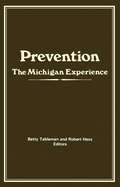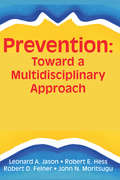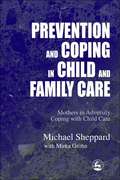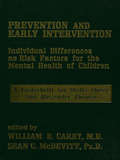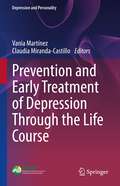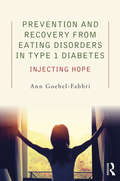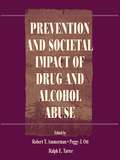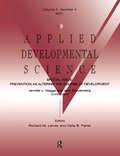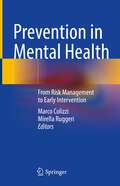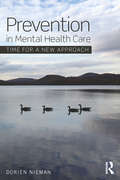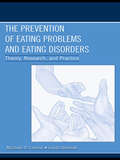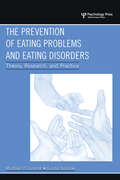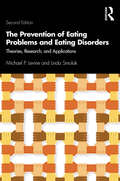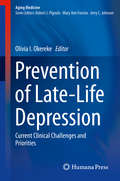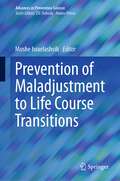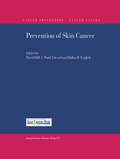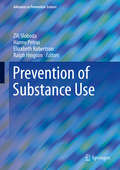- Table View
- List View
Prevention: The Michigan Experience
by Robert E HessProviding practical information for all prevention professionals, this helpful volume presents an in-depth look at the excellent program models and prevention efforts used in the state of Michigan. Contributors discuss pilot demonstrations and model developments to illustrate what a state can do to further prevention efforts.
Prevention: The Michigan Experience
by Robert E HessProviding practical information for all prevention professionals, this helpful volume presents an in-depth look at the excellent program models and prevention efforts used in the state of Michigan. Contributors discuss pilot demonstrations and model developments to illustrate what a state can do to further prevention efforts.
Prevention: Toward a Multidisciplinary Approach
by Robert E HessThis new book takes a detailed look at different disciplines as they relate to prevention. Authors examine how a multidisciplinary approach to prevention can refine and increase the effectiveness and comprehensiveness of the field. Given the complexity of the problems facing society today, many professionals are recognizing the strong need for collaborative efforts in the area of prevention. Prevention: Toward a Multidisciplinary Approach will help you gain a clearer perspective of this need and will provide invaluable insights into the intitial steps required for successful collaboration.
Prevention: Toward a Multidisciplinary Approach
by Robert E HessThis new book takes a detailed look at different disciplines as they relate to prevention. Authors examine how a multidisciplinary approach to prevention can refine and increase the effectiveness and comprehensiveness of the field. Given the complexity of the problems facing society today, many professionals are recognizing the strong need for collaborative efforts in the area of prevention. Prevention: Toward a Multidisciplinary Approach will help you gain a clearer perspective of this need and will provide invaluable insights into the intitial steps required for successful collaboration.
Prevention and Control of Aggression and the Impact on its Victims
by Manuela MartinezProceedings of the XIV World Meeting of the International Society for the Research on Aggression: Prevention and Control of Aggression and the Impact on its Victims, held in July 9-14, 2000, in Valencia, Spain. Aggression is an aspect of human society that has interested scientists for many decades, and their work has provided important knowledge about its causes and way to prevent and control this behavior. However, not only scientists but many professionals working in the wide spectrum of society, from family to international policy, are interested in having programs of interventions capable of reducing aggression and violence in our society. This comprehensive book is a compendium of most research approaches that are currently taking place in the field of aggression, focusing on the interventions to control and prevent this behavior and the impact on its victims. The chapters of the book include biological approaches to aggression, such as neuroanatomy, neurochemistry, neuroendocrinology, genetics and psychopathology; information about aggression in children and adolescents in different settings such as family, school and community; characteristics if aggression in specific relationships such as marital and sexual, and specific settings such as bars, prisons and traffic; and cultural approaches to aggression, social prejudice, war and programs of peace. Furthermore, a small number of representative chapters about victims are included, ranging from the impact of aggression on behavior and physiology in animal models to victims of war. As this book highlights, the interventions to prevent and control aggression have to be diverse (highly heterogenic) in order to deal with all aspects of human beings and society, ranging from pharmacological control in individuals to programs of peace to promote respect among people and among nations. Scientists, academics and professionals dealing with any facet of aggression and its impact on our society will obtain in this book information about the complexity of this research field and the ways to approach our objective: eliminate aggression from the human behavioral repertoire.
Prevention and Coping in Child and Family Care: Mothers in adversity coping with child care (PDF)
by Michael SheppardHow do mothers cope with child care and associated problems when, in adversity, they do not gain access to social service support? This book considers the important question of mothers' coping strategies when they are in adversity. Drawing upon the women's own accounts, it focuses not only on what they do themselves to deal with their problems, but how they integrate their own problem solving approaches with the use of supports. It also examines the way in which women cope with their own emotional responses to these problems. The women themselves, and their own accounts are placed 'centre stage' in this book. In doing this the book is able to create a major development in our understanding of the nature of Prevention, a central concept in welfare provision. Drawing upon Coping theory, and the findings of this study, this book extends and develops the concept of Prevention, creating a multidimensional model in which the actions of the mother herself (and other primary caregivers) are included alongside traditional domains. It will be of interest to a variety of academic and professional disciplines, including those interested in gender studies, sociology, social policy, as well as social work and health professionals.
Prevention And Early Intervention
by William B. Carey Sean C. McDevitPublished in 1994, Prevention And Early Intervention is a valuable contribution to the field of Psychiatry/clinical Psychology.
Prevention And Early Intervention
by William B. Carey Sean C. McDevitPublished in 1994, Prevention And Early Intervention is a valuable contribution to the field of Psychiatry/clinical Psychology.
Prevention and Early Treatment of Depression Through the Life Course (Depression and Personality)
by Vania Martínez Claudia Miranda-CastilloThis book presents current evidence of new perspectives for the prevention and appropriate management of depression in people across the life course. Special attention has been dedicated to facilitating factors for the development of health system capacity and the effectiveness of the different types of interventions. The first part of the book reviews the innovations in global prevention and non-pharmacological treatments for children, adolescents, and youths. The second part reviews interventions for adults across the lifespan, including older adults and caregivers. Despite the efforts to tackle depression, the COVID-19 pandemic directly or indirectly affected the mental health of the population, including an increase in the incidence of depressive disorders, which are underdiagnosed and undertreated in young and older people. Because of the characteristics of adolescence and older adulthood, people can consider depression signs and symptoms as natural, neglecting a proper diagnosis. To address these challenges in the clinical management of depression, Prevention and Early Treatment of Depression Through the Life Course presents a life course perspective on the analysis and treatment of depression to help clinical psychologists, psychiatrists and other mental health professionals understand the mechanisms associated with the onset of depression and identify/develop proper evidence-based treatments for different ages and in different circumstances.
Prevention and Recovery from Eating Disorders in Type 1 Diabetes: Injecting Hope
by Ann Goebel-FabbriPrevention and Recovery from Eating Disorders in Type 1 Diabetes: Injecting Hope sheds light on an often overlooked and misunderstood issue: the problem of eating disorders in women with type 1 diabetes – referred to by lay people and the media as "diabulimia" and characterized by insulin restriction as a means of calorie purging for weight loss. Drawing on a series of recent interviews and over 16 years of research and clinical experience with this unique phenomenon, author Dr. Ann Goebel-Fabbri provides groundbreaking insight into the lives of women who have recovered from eating disorders in type 1 diabetes. She explores the condition's origins, its effects on the lives of those affected, and possible paths to recovery. Also included are suggestions for prevention and treatment, as well as practical and inspirational advice from now-recovered women. Prevention and Recovery from Eating Disorders in Type 1 Diabetes is a valuable guide for patients and loved ones, diabetes treatment teams, and eating disorder clinicians.
Prevention and Recovery from Eating Disorders in Type 1 Diabetes: Injecting Hope
by Ann Goebel-FabbriPrevention and Recovery from Eating Disorders in Type 1 Diabetes: Injecting Hope sheds light on an often overlooked and misunderstood issue: the problem of eating disorders in women with type 1 diabetes – referred to by lay people and the media as "diabulimia" and characterized by insulin restriction as a means of calorie purging for weight loss. Drawing on a series of recent interviews and over 16 years of research and clinical experience with this unique phenomenon, author Dr. Ann Goebel-Fabbri provides groundbreaking insight into the lives of women who have recovered from eating disorders in type 1 diabetes. She explores the condition's origins, its effects on the lives of those affected, and possible paths to recovery. Also included are suggestions for prevention and treatment, as well as practical and inspirational advice from now-recovered women. Prevention and Recovery from Eating Disorders in Type 1 Diabetes is a valuable guide for patients and loved ones, diabetes treatment teams, and eating disorder clinicians.
Prevention and Societal Impact of Drug and Alcohol Abuse
by Robert T. Ammerman Peggy J. Ott Ralph E. TarterIt is generally acknowledged that the most cost-effective means of curtailing alcohol and drug abuse is prevention. Providing interventions to at-risk individuals before they develop serious problems with substance use is the most important component of the "war on drugs." Fortunately, the past decade has seen a dramatic increase in the quantity and quality of scientific research on those areas crucial to the advancement of prevention science. This book compiles a tremendous amount of information about prevention which has accumulated in recent years. Documenting these accomplishments and setting the stage for future efforts comprise the focus of this book. Prevention and Societal Impact of Drug and Alcohol Abuse is divided into four parts. Part I contains introductory chapters addressing current issues in prevention science and characteristics of abusable substances. Part II includes chapters on the historical contexts of substance abuse and the deleterious health consequences of alcohol and other drugs. Part III focuses on the impact of drug and alcohol abuse on society. Included are chapters on alcohol and drug abuse and driving, infectious illness, disability, managed care, the criminal justice system and adolescents and adults, sale and distribution, the media, and community responses. Part IV consists of chapters on prevention in specific settings and with certain populations.
Prevention and Societal Impact of Drug and Alcohol Abuse
by Robert T. Ammerman Peggy J. Ott Ralph E. TarterIt is generally acknowledged that the most cost-effective means of curtailing alcohol and drug abuse is prevention. Providing interventions to at-risk individuals before they develop serious problems with substance use is the most important component of the "war on drugs." Fortunately, the past decade has seen a dramatic increase in the quantity and quality of scientific research on those areas crucial to the advancement of prevention science. This book compiles a tremendous amount of information about prevention which has accumulated in recent years. Documenting these accomplishments and setting the stage for future efforts comprise the focus of this book. Prevention and Societal Impact of Drug and Alcohol Abuse is divided into four parts. Part I contains introductory chapters addressing current issues in prevention science and characteristics of abusable substances. Part II includes chapters on the historical contexts of substance abuse and the deleterious health consequences of alcohol and other drugs. Part III focuses on the impact of drug and alcohol abuse on society. Included are chapters on alcohol and drug abuse and driving, infectious illness, disability, managed care, the criminal justice system and adolescents and adults, sale and distribution, the media, and community responses. Part IV consists of chapters on prevention in specific settings and with certain populations.
Prevention As Altering the Course of Development: A Special Issue of applied Developmental Science
by Jennifer L. Maggs John E. SchulenbergPrevention and developmental sciences have many complementary goals and much to gain by collaboration. With random assignment to conditions and long-term multivariate follow-up of individuals across significant years in the life span, fundamental basic and applied research questions can now be addressed using new statistical methods. This special issue includes four empirical papers that used growth modeling techniques (hierarchical linear modeling, latent growth curve analyses) to examine direct and indirect effects of theory-based, longitudinal prevention experiments on developmental trajectories of children's and adolescents' substance use, delinquency, and school bonding.
Prevention in Mental Health: From Risk Management to Early Intervention
by Marco Colizzi Mirella RuggeriThe book brings together into a single text the interrelated but different research efforts to translate the current evidence on risk and outcome of severe mental disorders into a preventive perspective. The book also introduces a holistic approach to prevention in mental health, by combining biological, psychological and environmental evidence that attempts to blunt the risk and reduce the number of individuals with mental health vulnerabilities who eventually progress to the manifestation of a severe mental disorder. Finally, the book wants also to highlight the possibility to overcome the single disorder-oriented preventive approach in an attempt to intercept a wider at-risk youth population and explore clinical research areas underperformed where future efforts will have to concentrate. Mental health problems have their peak of incidence during the transition from childhood to young adulthood, interesting up to 20% adolescents. Half of those eventually developing such difficulties experience clinically relevant mental distress by the age of 14. Even more importantly, the symptomatic onset is generally anticipated by non-specific warning signs of psychosocial impairment potentially evolving in any severe mental disorder. This is of crucial importance, as almost one in two health problems contributing to the global disease burden across the 0-25 age span is a mental disorder. The search for preventive strategies among youth has developed over the past 2-3 decades, invigorated by a rethinking of mental disorders’ ineluctable prodromal phase into a period where the trajectory of illness can be slowed down, blunted, or even halted. The paradigms for implementing preventing approaches in mental health have often developed independent of each other. This book aims at summarizing the available evidence and make a step towards a more mature vision of the potentialities of promotion and prevention in mental health.
Prevention in Mental Health Care: Time for a new approach
by Dorien NiemanPrevention in Mental Health Care: Time for a new approach focuses on the limitations in current psychiatric practice and research. Many professionals working in mental health care, as well as patients with psychiatric symptoms, are dissatisfied with what is currently offered by the discipline, with respect to the diagnosis and treatment of psychiatric disorders. This book discusses possibilities and opportunities for change, and is the first to combine recent scientific research results with insights from philosophy and art. Illustrating these points with elaborate case studies, Prevention in Mental Health Care promotes a deeper understanding and a new model of mental health care, with an emphasis on prevention and natural recovery. Prevention in Mental Health Care will be of use to qualified or trainee practitioners, clinical psychologists, psychiatrists, social workers, occupational therapists and nurses working with the current classification systems and treatment methods in psychiatry. Furthermore, the book will appeal to students, lecturers and researchers, as well as those with a general interest in mental health care.
Prevention in Mental Health Care: Time for a new approach
by Dorien NiemanPrevention in Mental Health Care: Time for a new approach focuses on the limitations in current psychiatric practice and research. Many professionals working in mental health care, as well as patients with psychiatric symptoms, are dissatisfied with what is currently offered by the discipline, with respect to the diagnosis and treatment of psychiatric disorders. This book discusses possibilities and opportunities for change, and is the first to combine recent scientific research results with insights from philosophy and art. Illustrating these points with elaborate case studies, Prevention in Mental Health Care promotes a deeper understanding and a new model of mental health care, with an emphasis on prevention and natural recovery. Prevention in Mental Health Care will be of use to qualified or trainee practitioners, clinical psychologists, psychiatrists, social workers, occupational therapists and nurses working with the current classification systems and treatment methods in psychiatry. Furthermore, the book will appeal to students, lecturers and researchers, as well as those with a general interest in mental health care.
The Prevention of Eating Problems and Eating Disorders: Theory, Research, and Practice
by Michael P. Levine Linda SmolakThis is the first authored volume to offer a detailed, integrated analysis of the field of eating problems and disorders with theory, research, and practical experience from community and developmental psychology, public health, psychiatry, and dietetics. The book highlights connections between the prevention of eating problems and disorders and theory and research in the areas of prevention and health promotion; theoretical models of risk development and prevention (e.g., developmental psychopathology, social cognitive theory, feminist theory, ecological approaches); and related research on the prevention of smoking and alcohol use. It is the most comprehensive book available on the study of prevention programs, especially for children and adolescents.The authors review the spectrum of eating problems and disorders, the related risk and protective factors, the models that have guided prevention efforts to date, the literature on the studies of prevention, and suggestions for curriculum and program development and evaluation. The book concludes with a new prevention program based on the Feminist Ecological Developmental model. The 800 + references highlight work done around the world.The Prevention of Eating Problems and Eating Disorders addresses: * methodologies for assessing and establishing prevention;* the implications of neuroscience for prevention;* dramatic increases in the incidence of obesity;* the role of boys, men, and the media on body image;* prevention programming for minority groups; and* whether to focus on primary or secondary prevention.Intended for clinicians and academicians from disciplines such as health, clinical, developmental, and community psychology; social work; medicine; and public health; this book is also an ideal text for advanced courses on eating disorders.
The Prevention of Eating Problems and Eating Disorders: Theory, Research, and Practice
by Michael P. Levine Linda SmolakThis is the first authored volume to offer a detailed, integrated analysis of the field of eating problems and disorders with theory, research, and practical experience from community and developmental psychology, public health, psychiatry, and dietetics. The book highlights connections between the prevention of eating problems and disorders and theory and research in the areas of prevention and health promotion; theoretical models of risk development and prevention (e.g., developmental psychopathology, social cognitive theory, feminist theory, ecological approaches); and related research on the prevention of smoking and alcohol use. It is the most comprehensive book available on the study of prevention programs, especially for children and adolescents.The authors review the spectrum of eating problems and disorders, the related risk and protective factors, the models that have guided prevention efforts to date, the literature on the studies of prevention, and suggestions for curriculum and program development and evaluation. The book concludes with a new prevention program based on the Feminist Ecological Developmental model. The 800 + references highlight work done around the world.The Prevention of Eating Problems and Eating Disorders addresses: * methodologies for assessing and establishing prevention;* the implications of neuroscience for prevention;* dramatic increases in the incidence of obesity;* the role of boys, men, and the media on body image;* prevention programming for minority groups; and* whether to focus on primary or secondary prevention.Intended for clinicians and academicians from disciplines such as health, clinical, developmental, and community psychology; social work; medicine; and public health; this book is also an ideal text for advanced courses on eating disorders.
The Prevention of Eating Problems and Eating Disorders: Theories, Research, and Applications
by Michael P. Levine Linda SmolakIn a detailed analysis of the field of eating problems and disorders, this book highlights the connections between the prevention of eating problems and disorders, and theory and research in the areas of prevention and health promotion. It also looks at models of risk development and prevention, specific issues and challenges, the status of current prevention research, and lessons for prevention program development. In this unique text Levine and Smolak draw on a range of interdisciplinary perspectives, including prevention science, developmental psychology, public health, and neuroscience, to provide a thorough review, history, and critique of the topic in light of a range of empirical studies. The only authored volume with a broad, detailed and integrated view of theories, research, and practice, this expanded, fully revised, and updated new edition features new chapters on dissonance-based approaches, public health, biopsychiatry and neuroscience, gender, culture(s), technology, obesity, protective factors, and ecological approaches. The Prevention of Eating Problems and Eating Disorders: Theories, Research, and Applications is essential reading for clinicians, academics, researchers, graduate students, upper-level undergraduates, and activists and advocates involved in work pertaining to eating disorders, disordered eating, prevention, health promotion, body image, obesity and biopsychosocial perspectives.
The Prevention of Eating Problems and Eating Disorders: Theories, Research, and Applications
by Michael P. Levine Linda SmolakIn a detailed analysis of the field of eating problems and disorders, this book highlights the connections between the prevention of eating problems and disorders, and theory and research in the areas of prevention and health promotion. It also looks at models of risk development and prevention, specific issues and challenges, the status of current prevention research, and lessons for prevention program development. In this unique text Levine and Smolak draw on a range of interdisciplinary perspectives, including prevention science, developmental psychology, public health, and neuroscience, to provide a thorough review, history, and critique of the topic in light of a range of empirical studies. The only authored volume with a broad, detailed and integrated view of theories, research, and practice, this expanded, fully revised, and updated new edition features new chapters on dissonance-based approaches, public health, biopsychiatry and neuroscience, gender, culture(s), technology, obesity, protective factors, and ecological approaches. The Prevention of Eating Problems and Eating Disorders: Theories, Research, and Applications is essential reading for clinicians, academics, researchers, graduate students, upper-level undergraduates, and activists and advocates involved in work pertaining to eating disorders, disordered eating, prevention, health promotion, body image, obesity and biopsychosocial perspectives.
Prevention of Late-Life Depression: Current Clinical Challenges and Priorities (Aging Medicine #9)
by Olivia I. OkerekeThis book illustrates the imperative for late-life depression prevention, introducing a broad range of approaches to prevention and provides detailed examples of clinical applications of late-life depression prevention – all with consideration of medical and scientific, social, economic and global health perspectives. Clear guidelines are delineated for assessing, treating and preventing such conditions as depression and anxiety, dementia, psychosis and mania, sleep disturbances and personality disorders. Written by experts in the field, this text considers the complicating conditions that depression may incur higher costs and create during the course and treatment of comorbid major medical conditions that are also highly prevalent in older adults – including diabetes, hypertension and heart disease.Prevention of Late-Life Depression: Current Clinical Challenges and Priorities is an important new volume that will be useful to all providers that are concerned with the mental health of our rapidly expanding aged population.
Prevention of Maladjustment to Life Course Transitions (Advances in Prevention Science)
by Moshe IsraelashviliThis book provides a comprehensive and updated review of the concepts, models, and interventions related to the process of adjustment to life course transitions. In times of transition, an individual is exposed to experiences that require them to assume new roles and exhibit updated behaviors. Regardless of the characteristics of these transitions, exposure to normative trajectories imposes on the person an intensive engagement in a process of (re-)adjustment. Sometimes this demand is beyond the scope of one's ability, motivation, or comprehension. Hence, some people might ineffectively perceive and/or react to the change and end up feeling unable to handle the change and inclined to escape the situation. A preventive intervention that either reduces the impact of possible risk factors or fosters possible protective factors would support the people in managing the transition. While the importance of prevention of maladjustment is repeatedly mentioned in the literature, this is the first-known book on how to prevent maladjustment. It examines how the sense of transition emerges, what adjustment means, the models that elaborate on how people manage in times of transition, what the antecedents of maladjustment are, and especially how maladjustment could be prevented. Out of these discussions, a new model, The Transitional Stress and Adjustment (TSA) Model, is suggested as a grand framework for paving a way forward to better prevent people's maladjustment to life course transitions. Prevention of Maladjustment to Life Course Transitions is a much-needed cornerstone in the future development within the prevention science framework. This book has interdisciplinary appeal for researchers, practitioners, and graduate students in psychology, sociology, public health, social work, criminology, medicine, health sciences, public policy, economics, and education who consider prevention an important vehicle of intervention to promote health and wellbeing. Its focus on the topic of adjustment also would be of special interest to those who explore child and youth development.
Prevention of Skin Cancer (Cancer Prevention-Cancer Causes #3)
by David Hill J. Mark Elwood Dallas R. EnglishOur series Cancer Prevention - Cancer Control continues to address the causes and prevention of cancer. In this volume, Hill, Elwood, and English bring together a rich resource summarizing the state of science underpinning the primary prevention of skin cancer. While skin cancer causes an increasing burden, particularly in populations of European origin, our understanding of the role of sun exposure together with the genetic components of skin cancer continues to grow. Given the emphasis on evidence-based medicine and public health prevention efforts, it is noteworthy that, although we can all access the same evidence base, countries around the world have had remarkably different responses to the application of this knowledge to prevent skin cancer. The outstanding contribution of the Australian public health community to the scientific understanding of skin cancer etiology and the translation of this knowledge into national prevention efforts uniquely positions the editors to compile this volume focused on the primary prevention of skin cancer. In so doing they draw on an international team of authors to present a “state of the science” summary of skin cancer prevention and to identify those areas where uncertainty remains. To achieve successful prevention of cancer we must translate our scientific knowledge base into effective prevention programs. This book offers the reader keen insights into the depth of our understanding of etiologic pathways for skin cancer. This etiologic science base is complemented by rigorous prevention science placing emphasis on the social context for effective and sustained prevention efforts.
Prevention of Substance Use (Advances in Prevention Science)
by Zili Sloboda Hanno Petras Elizabeth Robertson Ralph HingsonThis volume provides a serious examination of substance use prevention research and practice as components of the continuum from health promotion through to prevention and health care in sub-groups and in the general population. Extensive background chapters provide portals into the evolution of the field and the cutting edge research being conducted on the etiology, epidemiology, and genetics of substance use and abuse. The global nature and health burden of substance use and abuse incorporates assessments of the serious problems related to the prevention of legal substance use (i.e., alcohol and tobacco) and how lessons learned in those arenas may apply to the prevention of illicit substance use. Research and practice chapters detail a range of effective evidence-based programs, policies and practices and emerging prevention interventions from the literatures on the family and school contexts in addition to innovations involving mindfulness and the social media. Continued advancements in substance use prevention research, practice, training, and policy are projected.Included among topics addressed are:Progression of substance use to abuse and substance use disordersThe tobacco prevention experience: a model for substance use prevention?Policy interventions: intended and unintended influences on substance useQualitative methods in the study of psychoactive substance useUse of media and social media in the prevention of substance useSupporting prevention science and prevention research internationallyThe array of research accomplishments and real-world methods presented in Prevention of Substance Use merits the attention of a variety of researchers and practitioners, including public health professionals, health psychologists, and epidemiologists.
